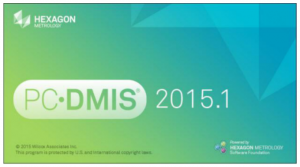 PC-DMIS is the world’s most popular CMM software for the collection, evaluation, management and presentation of manufacturing data. The standard on Hexagon Metrology measurement devices PC-DMIS is also available on a wide range of non-Hexagon equipment. Use it to fully leverage your manufacturing process and build truly lean systems.
PC-DMIS is the world’s most popular CMM software for the collection, evaluation, management and presentation of manufacturing data. The standard on Hexagon Metrology measurement devices PC-DMIS is also available on a wide range of non-Hexagon equipment. Use it to fully leverage your manufacturing process and build truly lean systems.
PC-DMIS is the world’s leading measurement software, with over 60 000 seats in place worldwide. Its powerful capabilities enable users to measure everything from simple prismatic parts to the most complex aerospace and automotive components. PC-DMIS leads the way in revolutionizing measurement, pioneering technologies such as:
- Use of CAD models in the inspection process
- Directly linking CAD systems and measurement software through its Direct CAD Interface (DCI) technology
- Implementing a full set of sheet metal measurement routines tailored for the automotive industry
- Digitally simulating measurement in an offline virtual CMM environment
- Easily aligning complex contoured parts using breakthrough iterative alignment technology
PC-DMIS is standard equipment on all Hexagon Manufacturing Intelligence measurement devices and is also available as a retrofit package for most other measurement equipment manufacturers, allowing users of non-Hexagon equipment to take advantage of PC-DMIS technology. PC-DMIS comes in three basic configurations, Pro, CAD and CAD++, with optional modules available to fine-tune for specific needs. It is also available in an offline version for virtual programming.
TTP Free Form Plane Strategy
The Touch Trigger Probe (TTP) Free Form Plane strategy for the Plane Auto Feature measures a plane by selecting hit points along a path defined by a set of points (scan path). The path can be continuous, contain a break, or contain move points. Break and move points in the path can help to measure a face as one single plane. The advantage of this strategy is you can generate a scan path from which you can select a hit path.
TTP Plane Circle Strategy
The TTP Plane Circle strategy for the Plane Auto Feature generates hits points in a circular path to measure a plane and is available for touch trigger probes and scanning probes. As its name suggests, this strategy takes single hits and move points can be added to avoid obstructions in the path. The advantage of this strategy is you can generate a hit path according to the criteria you specify.
Travel Rack X1V Tool Changer
PC-DMIS now supports the Travel Rack X1V tool changer and, as the name suggests, travels with the bridge, greatly reducing the time to change tools.
Rotary Table with Error Map
PC-DMIS supports the rotary table with error map on Leitz range CMMs. This support is available on the B5 controller. You can index the rotary table on a Leitz range machine and use it for measurement purposes.
Measuring Distances on a Cross Section
The new Distance Gage option measures distances on a cross section using the nominal CAD or the measured polyline. The gauge uses the Distance Gage option’s size value to determine the amount of data PC- DMIS uses to calculate the measurement. If you enter 0 (zero), PC-DMIS uses the selected point for the distance gauge where the picked point is the centre of the measurement. For example, if you enter a size of 4 mm, PC-DMIS uses 2 mm on each side of the picked point. Annotation and distance gauge labels for a cross section are available in a report template that has a graphic image or in the Report Graphical Analysis template.
Cross Section Slide Show
The Cross Section toolbar has been added to the Point Cloud and QuickCloud toolbars for use on several device platforms. You can use the toolbar’s Cross Section Slide Show button to enable the Show Previous Cross Section and Show Next Cross Section arrow buttons. These buttons display individual cross sections in 2D (Show Only) view. They also enable you to move from one cross section to another.
Adaptive Illumination Calibration
The new Adaptive Illumination calibration routine intends to compensate for the sharp illumination ramp we see at lower magnifications and improve the inconsistent illumination across different machine frames. As the Adaptive Illumination Calibration may significantly change the illumination output and affect existing measurements routines it is possible to select or deselect this option.
